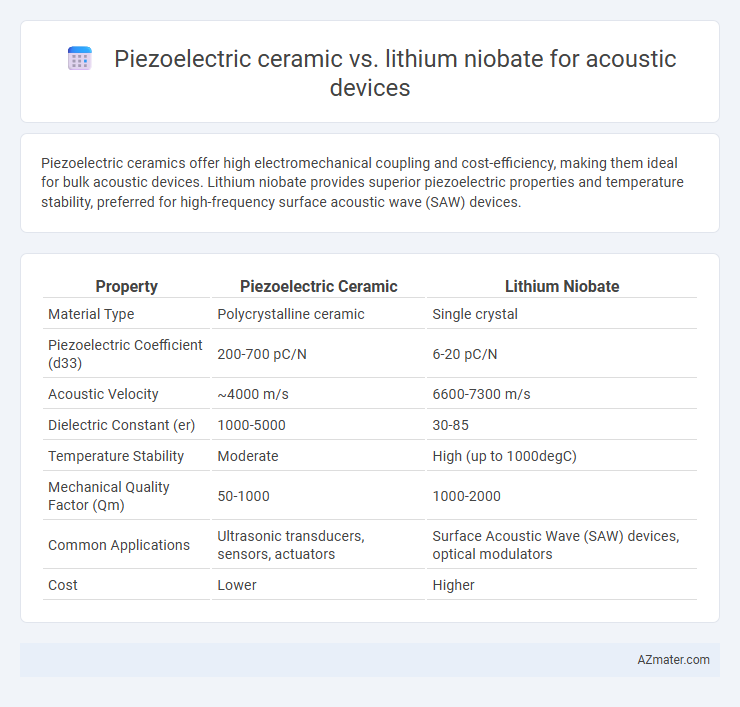Piezoelectric ceramics offer high electromechanical coupling and cost-efficiency, making them ideal for bulk acoustic devices. Lithium niobate provides superior piezoelectric properties and temperature stability, preferred for high-frequency surface acoustic wave (SAW) devices.
Table of Comparison
| Property | Piezoelectric Ceramic | Lithium Niobate |
|---|---|---|
| Material Type | Polycrystalline ceramic | Single crystal |
| Piezoelectric Coefficient (d33) | 200-700 pC/N | 6-20 pC/N |
| Acoustic Velocity | ~4000 m/s | 6600-7300 m/s |
| Dielectric Constant (er) | 1000-5000 | 30-85 |
| Temperature Stability | Moderate | High (up to 1000degC) |
| Mechanical Quality Factor (Qm) | 50-1000 | 1000-2000 |
| Common Applications | Ultrasonic transducers, sensors, actuators | Surface Acoustic Wave (SAW) devices, optical modulators |
| Cost | Lower | Higher |
Introduction to Acoustic Devices
Piezoelectric ceramics like PZT and lithium niobate are essential materials in acoustic devices due to their efficient electromechanical coupling properties. Piezoelectric ceramics offer high piezoelectric coefficients and mechanical robustness, making them ideal for ultrasonic transducers and sensors, while lithium niobate provides superior electro-optic properties and high-frequency performance in surface acoustic wave (SAW) devices. The choice between these materials depends on application-specific requirements such as frequency range, sensitivity, and environmental stability.
Overview of Piezoelectric Ceramics
Piezoelectric ceramics, primarily composed of lead zirconate titanate (PZT), offer high piezoelectric coefficients and excellent electromechanical coupling, making them ideal for acoustic devices such as sensors, actuators, and ultrasonic transducers. These materials exhibit strong mechanical robustness, high Curie temperatures, and cost-effective mass production compared to single-crystal lithium niobate. While lithium niobate provides superior frequency stability and low acoustic losses, piezoelectric ceramics excel in sensitivity and power output for a wide range of acoustic applications.
Properties of Lithium Niobate
Lithium niobate exhibits superior piezoelectric and electro-optic properties compared to traditional piezoelectric ceramics, making it ideal for high-frequency acoustic devices and integrated photonics. Its high Curie temperature and strong electromechanical coupling coefficients enable stable performance under harsh conditions and enhanced signal conversion efficiency. The material's low acoustic loss and excellent wavelength versatility support precise surface acoustic wave (SAW) and bulk acoustic wave (BAW) device applications, outperforming many ceramic counterparts.
Piezoelectric Response Comparison
Piezoelectric ceramics such as PZT exhibit higher piezoelectric coefficients (d33 values typically ranging from 200 to 600 pC/N) compared to lithium niobate, which generally has lower coefficients around 7 pC/N. This significant difference in piezoelectric response translates to stronger mechanical-to-electrical energy conversion efficiency in ceramics, making them preferred for high-sensitivity acoustic devices. Lithium niobate's advantage lies in its superior electromechanical coupling for surface acoustic wave (SAW) applications despite its lower intrinsic piezoelectric response.
Frequency Performance and Bandwidth
Piezoelectric ceramics, such as PZT, typically offer higher electromechanical coupling coefficients, resulting in broader bandwidth and superior frequency performance for acoustic devices operating in the low to mid-frequency range. Lithium niobate excels in high-frequency applications due to its high acoustic velocity and stability, enabling sharper resonance peaks and narrow bandwidth suitable for precise filtering. The choice between piezoelectric ceramics and lithium niobate hinges on the required frequency range and bandwidth, with ceramics preferred for wide bandwidth devices and lithium niobate for high-frequency, narrowband acoustic applications.
Temperature Stability and Reliability
Piezoelectric ceramics, such as PZT, offer superior temperature stability with consistent electromechanical coupling across a broad range, making them highly reliable in varying thermal environments. Lithium niobate excels in high-frequency acoustic applications but exhibits greater sensitivity to temperature fluctuations, which can affect device performance and long-term stability. For acoustic devices requiring robust reliability and stable operation under diverse thermal conditions, piezoelectric ceramics are generally preferred over lithium niobate.
Manufacturing and Cost Differences
Piezoelectric ceramics such as PZT are typically more cost-effective and easier to manufacture in bulk due to established sintering and machining processes, making them suitable for high-volume acoustic device production. Lithium niobate requires complex crystal growth methods like the Czochralski process, resulting in higher material costs and more challenging fabrication steps such as precise orientation cutting and polishing. These manufacturing and cost differences influence the selection of materials depending on performance needs and budget constraints in acoustic sensor and transducer applications.
Application Suitability and Use Cases
Piezoelectric ceramics, such as lead zirconate titanate (PZT), offer high electromechanical coupling coefficients and durability, making them ideal for ultrasonic transducers, medical imaging devices, and industrial non-destructive testing. Lithium niobate exhibits superior piezoelectric and electro-optic properties, well-suited for surface acoustic wave (SAW) filters, optical modulators, and high-frequency signal processing in telecommunications. The choice between piezoelectric ceramics and lithium niobate depends on application frequency range, temperature stability, and sensitivity requirements, with ceramics preferred for robust, high-power applications and lithium niobate favored in precision acoustic sensing and integrated photonics.
Integration with Modern Electronics
Piezoelectric ceramics offer excellent compatibility with standard electronic circuits due to their stable electrical properties and ease of fabrication in compact forms, making them ideal for integrated acoustic devices. Lithium niobate provides superior electromechanical coupling and temperature stability, which enhance performance in high-frequency applications but can require more complex integration techniques with modern semiconductor technology. Both materials are critical in acoustic device design, but piezoelectric ceramics typically enable more straightforward integration with mass-produced, low-cost electronic systems.
Future Trends in Acoustic Device Materials
Piezoelectric ceramics, such as lead zirconate titanate (PZT), continue to dominate acoustic devices due to their high electromechanical coupling and cost-effectiveness, while lithium niobate offers superior temperature stability and frequency response for advanced applications. Emerging trends emphasize the development of lead-free piezoelectric ceramics and engineered lithium niobate crystals with tailored domain structures to enhance device performance and environmental sustainability. Integration of nanostructured materials and hybrid composites is expected to drive future innovations in acoustic sensors, transducers, and actuators, enabling higher sensitivity and broader operational bandwidth.

Infographic: Piezoelectric ceramic vs Lithium niobate for Acoustic device
 azmater.com
azmater.com